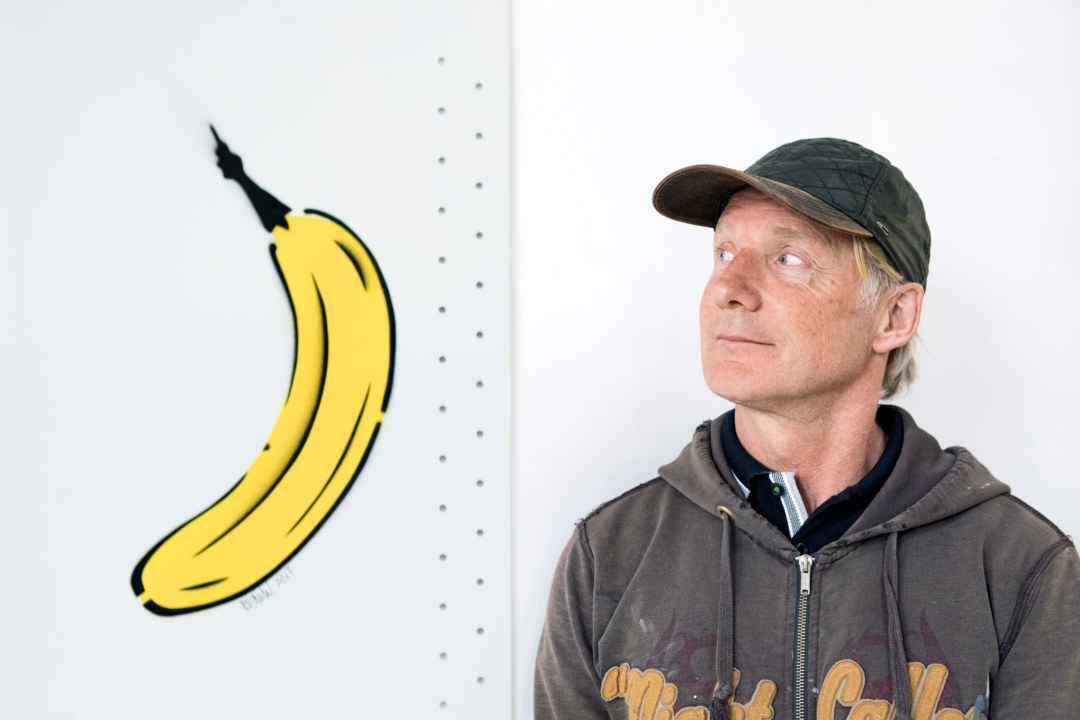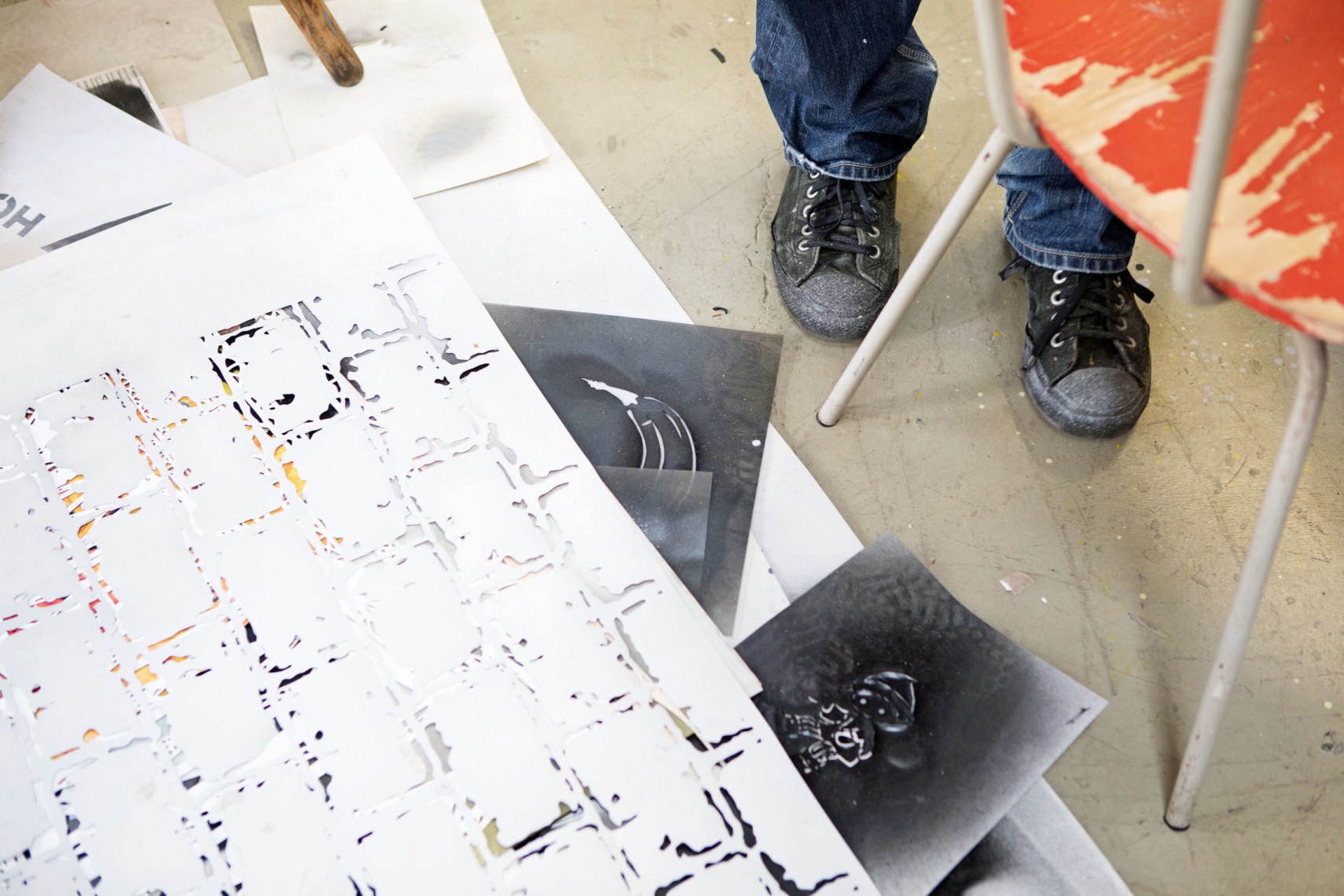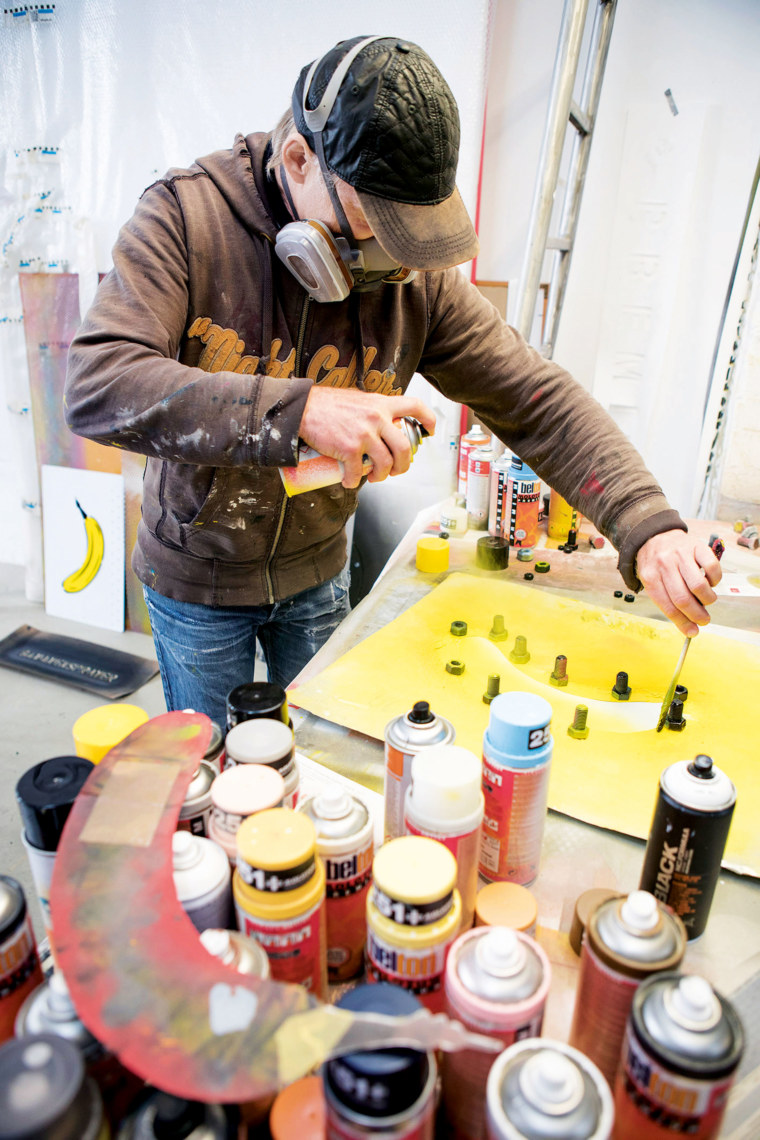“It’s neither beautiful nor ugly. It’s all about the impact.”

Banana for Wörwag: Baumgärtel sprays a “metamorphosis” of his original banana on a color panel.
Then he shakes the can and makes a couple of test movements with his wrist. As soon as he feels limbered up, he sprays.
Once, twice, three times. First short bursts, then a long one. With multiple sweeping gestures he transforms the white surface into a vibrant yellow. “I don’t need a cleanroom,” says Baumgärtel. “For me, there has to be dust floating in the air. I want texture. It can’t look lacquered.”
The first step on the way to the Wörwag banana has been taken. Baumgärtel closely observes the reaction. He still detects a trace of skepticism. “Art has to have an effect,” he remarks. “It’s neither beautiful nor ugly. It’s all about the impact.”
We’re standing in Baumgärtel’s studio in Leskan Park in the Dellbrück district of Cologne. In an old factory, he has converted a 6,458-square-foot (600 m2) space behind a historic façade into his own little banana republic—ample space for art projects and tropical fruit in myriad variations.
Bananas on canvases, stencils, prints, a banana sprayed on a sofa. Between canvas stretchers and behind shelves, the visitor discovers one banana after another.
No, says Baumgärtel, it’s not all about bananas with him. He knows all the plays on words surrounding the sweet fruit. And he finds almost all of them tired, hackneyed, banana’d out.
He’s careful not to give the impression that he finds it too tiresome. After all, the striking effect of the southern fruit has been his recipe for success for 30 years. He calls himself the banana sprayer, propagates banana pointillism, and makes good money with his famous Volksbanane—the people’s banana.
Perhaps it would have worked with other fruits as well, but ultimately the banana is a good that even politicians can’t keep their hands off of. EU Commission regulation 2257/94 sets forth standards regarding the color, size, and thickness of the fruit.
“Apparently the banana is so important that it has to be regulated,” he says with a sly grin. While his trademark does strictly conform to the standard, which only specifies minimum dimensions, at 15.75 inches (40 cm) long and an average thickness of 3.14 inches (8 cm), it undoubtedly exceeds what the Eurocrats in Brussels had in mind.
The second round of spraying is the decisive one. It’s the black contours that really lend the work its striking appearance. Baumgärtel carefully places a template on the yellow, picks up the can again, shakes it and again sprays in short bursts, and then longer ones. The paint is dried with hot air and impregnated. “Almost like car paint, right?”, says Baumgärtel.
He waits, impatiently, to be able to remove the stencil: “That’s the greatest moment, because that’s when you first see the banana.” But that won’t be for another half hour. Just to be sure. So nothing gets smeared.
Always on the run
In the early years, things had to go a bit quicker. As befits the lifestyle of a graffiti artist, Baumgärtel was frequently on the run. After all, many of his spraying activities were illegal. Once he even spent a night in jail.
Baumgärtel no longer knows for sure when and where he sprayed his first banana. Cologne’s Museum Ludwig was among the first, in 1987.
He was captured in a major sweep that very night. “I heard them call off the search on police radio. To this day I can’t help chuckling when I think of their announcement that it was just a painted banana.” The Cologne art temple, by contrast, found the matter less amusing. Baumgärtel was forced to pay a fine.
Years later, the museum director officially requested a banana. “This was one of the first times my stamp was recognized as a distinction that elevates a place to the stature of being a place of art,” says Baumgärtel. The transition from property-damaging menace to cult sprayer was a fluid one.

Banana Republic in a 6,458-square-foot (600 m2) space in Leskan Park in Cologne.
By now, Baumgärtel has honored almost 5,000 museums, galleries, and exhibitions with his fruity quality seal—from London and Paris to Zurich and Moscow.
He has even left his mark on the Guggenheim Museum in New York. Many people inquire about receiving bananas. “But they’re not for sale. You have to earn them,” emphasizes Baumgärtel. “The project is a psychological projection test in the world of art. The way galleries and museums treat the banana is how they treat art.”
The distinction can be traced back to a non-commercial project from his days as a psychology student. As in the Rorschach test, in which the observer’s reaction to inkblots is analyzed, Baumgärtel observed the looks, gestures, and statements that a banana can provoke.
At the moment they represent amazement and joy. The artist carefully lifts the stencil; the piece for Wörwag is finished. It will have a place of honor in Stuttgart. Now for the signature. Perfect. This yellow speaks every language. Baumgärtel smiles. The beaming President of the Banana Republic.

Yellow rules Thomas Baumgärtel’s world. In his studio in Cologne, he has created his own little banana cosmos.
Thomas Baumgärtel
1960 born in Rheinberg Germany’s Ruhr Valley
1985 to 1995 Studies of fine arts at the Cologne University of Applied Sciences and psychology at the University of Cologne
Baumgärtel has two children.
Emergence of the banana
During his civilian service at a Catholic hospital, Baumgärtel noticed that the Jesus figure was missing from a crucifix. He substituted a crucified banana peel instead. He’s been enthralled by the fruit ever since.

Michael Fiedler has headed Wörwag’s powder coating development division since 2010. To test the anti-graffiti paint, his team used spray paint, markers, and felt-tip pens.
Anti-graffiti paint
It’s not a new product, but demand is always strong: Wörwag’s anti-graffiti paint. The coating powder, a polyurethane, was developed almost 20 years ago. “The product has established itself on the market and proved its quality as a product,” says Michael Fiedler, head of powder coating development.
The special quality of this protective paint is its resistance both to spray paints and to chemical cleaning agents. It prevents paint from penetrating the protected surface and damaging it. The same applies to the cleaning agents with which graffiti is removed.
In 2016 alone, the German railway Deutsche Bahn spent some 8.6 million euros on graffiti removal. Perpetrators are particularly fond of tagging commuter trains, regional and freight trains, bridge posts, and noise protection barriers. Having their graffiti art roll through the country burnishes taggers’ fame.
To counteract this, Deutsche Bahn removes the graffiti within 24 to 72 hours. It’s a tedious, costly task and was the original motivation behind the request to Wörwag. The product that was then jointly developed by the two companies—a powder coating for the interior of the train cars—proved robust and easy to clean.
Photos: Petra Stockhausen
Text: Michael Thiem



